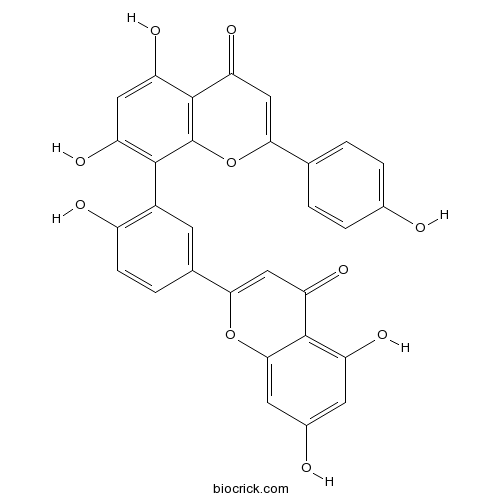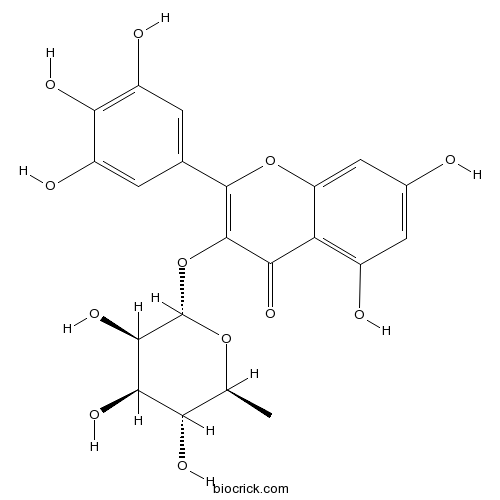Mangifera indica
Mangifera indica
1. The products in our compound library are selected from thousands of unique natural products; 2. It has the characteristics of diverse structure, diverse sources and wide coverage of activities; 3. Provide information on the activity of products from major journals, patents and research reports around the world, providing theoretical direction and research basis for further research and screening; 4. Free combination according to the type, source, target and disease of natural product; 5. The compound powder is placed in a covered tube and then discharged into a 10 x 10 cryostat; 6. Transport in ice pack or dry ice pack. Please store it at -20 °C as soon as possible after receiving the product, and use it as soon as possible after opening.
Natural products/compounds from Mangifera indica
- Cat.No. Product Name CAS Number COA
-
BCN6283
Amentoflavone1617-53-4
Instructions

-
BCN1136
Myricitrin17912-87-7
Instructions

-
BCN5535
Mangiferin4773-96-0
Instructions

Mangiferin attenuates cisplatin-induced acute kidney injury in rats mediating modulation of MAPK pathway.[Pubmed: 30083783]
Cisplatin has been confined due to the reported cases of nephrotoxicity. In the present study, an active xanthone, Mangiferin (from Mangifera indica) was investigated for its defensive role in cisplatin-induced nephrotoxicity. Male wistar albino rats were divided into six groups i.e., group 1 (normal); group 2 (cisplatin control); group 3, 4, and 5 (mangiferin 10, 20, and 40 mg/kg, i.p.); and per se (40 mg/kg; i.p.). The treatment was given for 10 days. On day 7, single dose of cisplatin 8 mg/kg i.p. was administered to induce nephrotoxicity in all groups except normal and per se. On day 11, animals were anesthetized, blood was taken from heart and serum was separated. Thereafter, rats were sacrificed and kidneys were isolated and preserved for histopathological, ultrastructural, immunohistochemical, and western blot analysis. Cisplatin control group showed significant impairment in renal function due to increased inflammation and oxidative stress which was also confirmed by histopathology and MAPK pathway proteins expression. However, pretreatment with mangiferin 20 and 40 mg/kg significantly reversed the renal function along with the structural changes and the levels of antioxidants. Mangiferin treatment attenuated DNA damage and apoptotic pathway.
Biosynthesis of zinc oxide nanoparticles usingMangifera indica leaves and evaluation of their antioxidant and cytotoxic properties in lung cancer (A549) cells.[Pubmed: 30037558]
Green synthesis is an eco-friendly approach to nanoparticle production, which eliminates the use of toxic chemicals, high temperatures, and costly equipment needed for traditional physical and chemical synthesis methods. This eco-friendly approach was used in the present study to biosynthesize zinc oxide nanoparticles (ZnO NPs) from Mangifera indica (mango) leaves which were then evaluated for their antioxidant activity and cytotoxic effects on lung cancer A549 cells. Synthesized ZnO nanoparticles were characterized using UV-vis spectroscopy, XRD, SEM, and EDX analyses. The XRD and SEM analyses showed 45-60 nm as the size of synthesized nanoparticles, the pure crystal form of ZnO NPs, and the shape of the NPs as nearly spherical and hexagonal quartzite. The antioxidant potential of nanoparticles was estimated using a DPPH free radical scavenging assay. The percent of viable cells was inversely proportional to the concentration of ZnO nanoparticles at 25 μg/mL concentration. The MTT assay used for cytotoxicity evaluation depicted the significant cytotoxic effect of ZnO NPs against the A549 lung cancer cell line. The drop in the proportion of viable A549 cells after exposure to ZnO NPs was comparable to the effects of the standard drug used i.e. cyclophosphamide. Antioxidant activity of NPs was increased by increasing the concentration of NPs. The present biosynthesis approach is rapid, inexpensive and eco-friendly and it yielded highly stable ZnO NPs with significant antioxidant and anticancer potential. This is the first report of M. indicia -mediated synthesis of ZnO NPs as antioxidant and, anticancer agents for the treatment of lung cancer and subsequent therapeutic applications.
Mini-Review- A mini-review of therapeutic potential of Mangifera indica L.[Pubmed: 30033432]
Among known species of 69 Mangifera, Mangifera indica L. is a medicinal plant being used in tropical regions by indigenous people. It has been a main plant species being used in Ayurvedic as well as indigenous medical systems form 4000 years. Components of M. indica are recurrently used as a traditional medicine system to cure numerous ailments. Active constituents are present in stem bark, leaves, heartwood, roots and fruit and have antioxidant, anti-inflammatory, radioprotective, antitumor, immune-modulatory, anti-allergic, anti-diabetic, anti-bone resorption, mono-amine oxidase inhibiting, anti-viral, anti-fungal, anti-bacterial, anti-spasmodic, antidiarrheal, anti-malarial, antiparasitic as well as lipolytic properties. In spite of essential progress in phyto-chemical and medicinal analysis of M. indica, more efforts are needed to explore M. indica active components and their application in pharmaceutical industry. In this review, we focus on recent information about chemical constituents and pharmacological uses of M. indica.
A comparison of sexual competitiveness and demographic traits of Anastrepha obliqua (Macquart) (Diptera: Tephritidae) among fruit-associated populations.[Pubmed: 30032728]
The control of Anastrepha obliqua includes the sterilization of mass-reared insects grown in isolation in a constantly controlled environment. Through time, laboratory mass-reared colonies may produce flies with lower field performance. To recover the genetic variation and aptitude of mass-reared populations, wild insects are introduced into mass-reared colonies. Our aim in this study was to determine whether the host species from two localities influence the life history traits of A. obliqua. We collected flies as larvae from infested fruits of Spondias purpurea, S. mombin, Mangifera indica cv. 'piña', and M. indica cv. 'coche' from two localities in Chiapas, Mexico. There were significant differences in the mating competitiveness of males collected from mango cv. 'coche' compared with mass-reared males. There were no differences in the mating propensity between flies from the two localities, even in the number of matings, when weight was considered as a covariable. The mass-reared strain showed the earliest age at first oviposition. The locality affected the longevity and oviposition period, and these influenced the birth rate, intrinsic rate of increase, finite rate of population increase, mean generation time, and doubling time. According to the demographic parameters, the population of S. mombin would allow artificial colonization in less time, considering that it has a high reproduction rate starting at an early age. Even in the propensity test, it had the highest number of matings. However, males with greater sexual competitiveness and longevity for colonization corresponded to those collected from S. purpurea.
Repression of WT1-Mediated LEF1 Transcription by Mangiferin Governs β-Catenin-Independent Wnt Signalling Inactivation in Hepatocellular Carcinoma.[Pubmed: 29953980]
The development of hepatocellular carcinoma (HCC) is a complex process which involves deregulation of multiple signalling pathways. The hyper-activation of Wnt signalling promotes sustained expansion, invasion, and neovascularization of HCC. Mangiferin, a natural small molecule present in Mangifera indica L. has been shown to inactivate β-catenin, which is an indispensable regulator in Wnt pathway. Our study aimed to determine whether mangiferin has any inhibitory effect on HCC and examine how it modulates Wnt signalling.
Pollen wall development in mango (Mangifera indica L., Anacardiaceae).[Pubmed: 29934739]
The mango (Mangifera indica) is a woody perennial crop currently cultivated worldwide in regions with tropical and subtropical climates. Despite its importance, an essential process such as pollen development, and, specifically, cell wall composition that influences crosstalk between somatic cells and the male germline, is still poorly understood in this species and in the Anacardiaceae as a whole. A detailed understanding of this process is particularly important to know the effect of low temperatures during flowering on pollen development that can be a limiting factor for fertilization and fruit set. To fill this gap, we performed a thorough study on the cell wall composition during pollen development in mango. The results obtained reveal a clear differentiation of the cell wall composition of the male germline by pectins, AGPs and extensins from the early developmental stages during microsporogenesis and microgametogenesis reflecting a restricted communication between the male germline and the surrounding somatic cells that is very sensitive to low temperatures. The combination of the results obtained provides an integrated study on cell wall composition of the male germline in mango that reveals the crucial role of the sporophyte and the gametophyte and the vulnerability of the process to low temperatures.
In-vitro investigation of anti-acne properties of Mangifera indica L. kernel extract and its mechanism of action against Propionibacterium acnes.[Pubmed: 29906773]
Propionibacterium acnes has been recognized as a main target for medical treatment of acne since this bacterium promotes acne inflammation by inducing upregulation of pro-inflammatory cytokines production, resulting in an accumulation of neutrophils and oxygen-free radicals produced by neutrophils within acne lesion. The aims of this study were to evaluate the biological activities of Mangifera indica kernel extracts grown in Northern Thailand (Kaew-Moragot cultivar), related to anti-acne properties including antimicrobial effect against acne-inducing bacteria together with the first elucidation of the mechanism of action against Propionibacterium acnes, anti-oxidation, and anti-inflammation. The kernels of M. indica, obtained from raw and ripe fruits, were macerated using various solvents. Agar diffusion and broth microdilution methods were performed to investigate the antibacterial activities of the extracts against P. acnes, Staphylococcus aureus, and Staphylococcus epidermidis. The ethanolic fractions exhibited the strongest antimicrobial effect against P. acnes with minimum inhibitory concentration and minimum bactericidal concentration of 1.56 mg/mL and 12.50 mg/mL, respectively. Bactericidal effect against P. acnes of these extracts could be observed after 3 h of incubation from time-kill curve. The chromatograms of high-performance liquid chromatography showed that the extracts existed gallic acid with high total phenolic content. These extracts additionally showed strong free radical scavenging properties on 2,2-diphenyl-1-picrylhydrazyl (DPPH) and 2,2-azino-bis-3-ethylbenzothiazoline-6-sulfonic acid (ABTS) as well as a notable inhibitory effect on linoleic acid peroxidation, which highly correlated to their antimicrobial effect, total phenolic, and gallic acid contents. The images, studied through using transmission electron microscopy, revealed that the extract certainly disrupted P. acnes cell membrane after exposure for 1 h as well as induced the consequent leakage of cytoplasmic materials. The inhibitory effects of the extracts on IL-8 secretion from LPS-inducing RAW 264.7 cells were also presented. In conclusion, the kernel extracts of raw M. indica fruit were effective against aerobic and anaerobic acne-inducing bacteria particularly P. acnes and exerted antioxidant along with anti-inflammatory activities. Therefore, the extracts might be potential agents for inflammatory acne treatment. However, clinical study is needed for further investigation.


